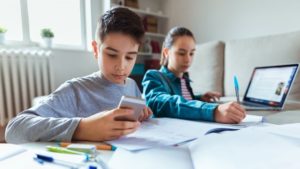Online Schooling and Closing the Homework Gap
By Aaron Leo
Millions of public-school students across the country are now being educated remotely due to the social distancing measures brought on by the spread of COVID-19. The challenge of holding lessons online has highlighted unequal access to technology faced by students across the country.
The “homework gap” – a term referring to the approximately 12 million school-age children who lack internet access or home computers needed to complete schoolwork remotely – has become a growing concern for educators who now rely almost entirely on the internet and other technology to teach.
The homework gap has laid bare inequalities across race and class. According to a PEW Research Report, for example, 25% of black teens said they often or sometimes cannot do homework assignments due to lack of reliable access to a computer or internet connectivity, compared with 13% of white teens and 17% of Hispanic teens.
Students from low-income families have been negatively impacted by the shift to online learning as well. Over one quarter of teens from low-income households do not have access to a home computer, and over one-third of all households with children ages 6 to 17 and an annual income below $30,000 a year do not have a high-speed internet connection at home. For households earning $75,000 per year, this number is just 6%.
Students living in rural areas where technological infrastructure is more likely to be absent or underdeveloped are also feeling the effects of the homework gap. A report by The Brookings Institute, for instance, reports that only two-thirds of rural Americans have access to a reliable broadband internet connection. In 15 states, less than half of all rural residents have such access.
Responding to a Crisis
Educators and policymakers have responded to this crisis through various measures. Many cities and towns have worked with internet providers to create “hot spots” which broadcast free Wi-Fi to those in the surrounding area. More than 7000 internet providers, telephone companies, and trade associations have signed the FCC’s “Keep America Connected Pledge” – an agreement to not terminate internet service over pandemic-related financial troubles, to waive late fees, and to allow free access to Wi-Fi services.
Many school districts have worked to ensure that all students have the necessary technology needed to learn online. Like other large districts across the country this task is particularly daunting as thousands of devices needed to be purchases and distributed.
Meanwhile, many school districts, recognizing the immediate needs of their most disadvantaged students, have organized drive-throughs where parents can pick up school materials for their children without leaving their vehicles or worry about accessing school documents online.
The Next Steps Forward
While educators and policymakers work to ensure that students have the proper technology and internet access to actively participate in remote learning, the social and economic impact of COVID-19 is sure to pose additional challenges. For instance, educators already report concerns over the emotional stress stemming from COVID-19. Maintaining access to important resources which schools provide to millions of students, like childcare and free or reduced lunches, is another high priority.
If any silver lining can be gleaned from this tragedy, it is that more attention may now be given to the needs of students disadvantaged in their access to technologies and who live with food insecurity.
Continue to follow NYKids’ News and view our Resources for more information on how educators are adapting to the changes brought on by this pandemic and utilizing technology to remotely educate their students. Please contact us at nykids@albany.edu with any feedback or suggestions.


